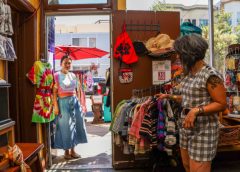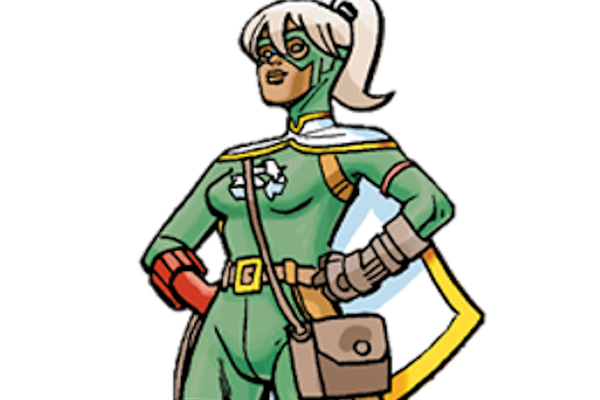
Local Vintage Shops and Designers Breathe New Life Into Old Clothes
[ad_1]
English
From the colorful storefronts of Haight-Ashbury to the sunny streets of the Mission, San Francisco is peppered with thrift shops selling secondhand clothes and vintage gems.
While the City by the Bay is among the more expensive cities to shop secondhand, San Francisco is host to a wide range of thrift, consignment and vintage brick-and-mortars where locals and out-of-towners can find everything from mid-century mod to midriff-exposing Y2K fashions.
Among the city’s array of secondhand shops are a handful of small businesses and ateliers that are building on the tradition of the thrift store by refreshing vintage looks with bespoke embellishments and sustainability in mind.
As the city celebrates National Thrift Shop Day, we take a look at a few shopkeepers and designers who specialize in repairing rips, modifying waistlines and making the old new again.
The Future Past
12 Clement St., San Francisco
thefuturepaststudio.com
Lindsey Hansen was tired of the churn and waste in the fashion industry—unworn garments sitting in warehouses, synthetic dyes polluting the Earth and a general disconnect between fashion buyers, makers and consumers in the global supply chain.

“I think for my entire career, I had this guilt about the amount of waste that I was contributing,” said Hansen, who worked in the fashion industry in Los Angeles for years and sometimes would crank out 90 jacket designs in a single month.
The Napa native finally decided to leave the grind behind, moving to San Francisco about 10 years ago. She opened her revived vintage garment boutique and atelier, The Future Past, on Clement Street in November 2019, just before the pandemic hit. At one point, the the Otis College of Art and Design-graduate was mostly making masks, but eventually her neighbors stumbled upon the shop, which specializes in customizing, tailoring and repairing vintage fashion pieces—particularly denim—and selling garments made out natural fabrics or hued with natural dyes.

“Because everybody was shopping hyper locally,” Hansen said, “it really helped me to root here and to focus on the people that were coming in.”
Now when a customer comes into the shop, they can peruse the upcycled garments of local designers or The Future Past’s collection of revived vintage pieces—ranging from jeans with sashiko stitching (a Japanese mending technique with white geometric threading on indigo backgrounds) to flour sacks turned into shirts. Customers can pick a piece off the rack to bespoke or bring in an heirloom piece they’d like to get repaired, altered or reworked for a more modern fit or style. Custom jobs can range from $5 to $10 to repair a button all the way up to $300 to rework an entire pair of jeans.

The seamstress, designer and proprietor hopes to one day host sewing classes at the shop. But until then, she wants her clients to feel comfortable in the store and in their wardrobe.
“I want people to feel like they can be themselves,” Hansen said. “That’s just the kind of experience I’m trying to really hone and nurture.”
That
3608 19th St., San Francisco
(415) 865-0969
issosf.com
Similary, sustainability has been the mission of Marie Biscarra’s and Ivy Chan’s boutique, Isso, for 15 years.

The funky and colorful shop on the corner of Guerrero and 19th streets not only sells wares “made, found or designed in the Bay Area” but has put its stamp on the hyperlocal fashion scene with its most popular upcycled seller over the last two years—a two-piece top-bottom set made out of oversized men’s polos shirts cut in half. Biscarra was inspired by the halter tops and two-piece outfits of 1960s Frankie Avalon “beach party movies” to repurpose the polos into cropped collared tops and sporty skirts.
“It just became a hot thing, and so we just never stopped,” Biscarra said. (Biscarra handles the designs and merchandizing, while Chan focuses on the sewing.)

Other items with a bespoke touch in the store include vintage jackets with San Francisco-themed patches made by a local artist and ruffled popcorn blouses cut up into crop tops or bandeaus. (If those the popcorn tops don’t sell, Biscarra is not opposed to cutting them into smaller scarves or scrunchies so the material doesn’t go to waste.)
“Our planet needs us to be more conscious of what we’re doing. So that’s just one thing that we’re trying to do ourselves to try to help out,” Biscarra said.
In the end, Biscarra hopes that Isso can inspire shoppers to not be “intimidated” by vintage fashion or secondhand clothes and find inspiration in them. “I like to consider what we carry in our shop to be classics with a twist,” Biscarra said. “So all of these vintage pieces, they’re timeless because they have traveled through time already, and they’re still here. Now the twist comes because each of us are going to wear this item in a different way, and we’re here to help you imagine that.”

WRN FRSH
wrnfrsh.com
Comfort and sustainability are also at the core of WRN FRSH, the brainchild of Gene Duven and Michael Falsetto-Mapp. Out of their Castro flat, the married couple produces lines, or “batches,” of unisex jackets, sweatshirts, pants and dresses sewn from “deconstructed vintage clothing” and sells their upcycled fashions at pop-ups, online or local shops, like The Future Past. Falsetto-Mapp finds and gathers the vintage garments and fabric materials (sometimes the couple receives donations), washes them, sorts them by fabric type and then the “deconstruction” process begins.
The couple cuts up the clothes into panels, which Duven then sorts, sews and assembles into WRN FRSH’s garments. The final products are unique patchworks with subtle variations in panel size and hue that are intentionally non-binary and bespoke in their own way.
“The paneling is always different,” explained Falsetto-Mapp. “It’s essentially one on one even though it’s within a collection.”
“They get some… individuality, but they’re also getting something that they understand,” added Duven, who feels freedom in being able to “manipulate sizes” and “disregard gender” in her work and being able to share that comfort with others.
“It being non-binary, is really central to our cut,” added Falsetto-Mapp. “We don’t have a men’s and women’s section. We never have. That was always intentional as a physical kind of a way to take control and take power back.”
Duven will customize the piece even further if say the client doesn’t want the material to be worn or have any holes or be more monochromatic.
“There’s a little bit of flexibility,” explained Falsetto-Mapp. “Because it’s just the two of us, and Gene’s making it by hand, we can make those adjustments.”
Ultimately, the couple hopes that their “yarn-to-table” work, as Falsetto-Mapp describes it, is an antidote to the heavy environmental impact of fast fashion.
“The way that we’re doing it is to most people kind of crazy because it takes a long time. We call it slow fashion,” Falsetto-Mapp said. “It’s very meticulous and takes a lot of purpose.”
English
[ad_2]
Source link



